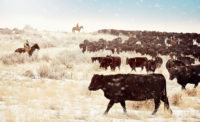Top industry economists predict continued high meat prices, especially for beef. The chief culprit is record high corn prices, created by a severe drought last year. While the industry experienced increased dollar sales in 2012, which are expected to extend into 2013, huge drought-driven side effects will continue to cause profitability problems.
Beef and chicken commanded higher expenditures, according to pork analyst Steve Meyer, Ph.D., President of Paragon Economics, Inc., Adel, Iowa. However, pork and turkey narrowly missed annual gains.
The path ahead will be treacherous, and not just from the weather. In the short term, the pace of the housing recovery, the wealth effect of a rising stock market and declines in unemployment rate are key influences. Over the longer term, federal spending policies will hang over the economy.
Rolling out of the drought?
The chance of a drought is 17% in any given year, says Paul Aho, Ph.D., President of Poultry Perspective, the same as rolling seven in a pair of dice. There has never been a drought two years in row. However, the western part of the USA mid-section is still in drought, although the recent heavy snowfall may bring relief.
Compounding the problem: the 2012 drought was the first in 24 years. The many years of plenty caused many producers to store less grain, resulting in declines of corn stocks at the end of every year since 2008, thus when crops failed there were no reserves.
The corn price forecast for 2013 is very uncertain, says Aho. However by 2014-2016, it should moderate at a level about halfway between now and 2002. Not only will U.S. production recover, but the record prices are driving record production in Argentina, Brazil, Ukraine and other countries.
Meats Fare Better in 2013?
Chicken is expected to recover this year. Prices have just passed break-even levels, stimulating growth in chicken production, especially in other countries. Some analysts project poultry consumption to surpass red meat in 2016.
Price of beef has increased every year since 2008, notes Randy Blach, CEO, CattleFax. The increase will continue into 2013 as production will decline 4%. Ranchers continued to cut herds in the face of the drought and packing plants are closing due to major over-capacity, most recently Cargill in Plainview, Texas.
If the weather continues to improve, Blach expects improved supply in 2014 and later. Ranchers are adding heifers up now, so production could increase in two years as they reach maturity. However, consumption will continue to decline, causing loss of share to pork and poultry.
Pork slaughter will be slightly higher in 2013, Meyer expects. Export records will also be set in 2013-14, despite Russia’s ban on animals that were fed lean additive ractopamine. However, expected prices and grain costs still show financial losses for pork producers next year.
Future Fortune
Global meat consumption is expected to continue increasing as the population grows and prospers. Water and other natural resources will continue to cause cost and supply concerns. Panelists at the Annual Meat Conference hoped that cost would not cause meat to become a luxury, with beef consumed only by middle class & above.
Meat industry outlook, 2013 and beyond
Weather, natural resources, consumer trends and the future of the meat industry





